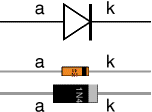 You can use different capacitor testers to test capacitor with different methods. The oldest way to carry out the test is to use an analog multimeter connecting a capacitor to the test probe. Then you judge the pointer through the panel to see if it comes up and down or not, indicating charging and discharging. It was easy to operate but the results it produced still cannot illustrate whether the capacitor value is good or not.
You can use different capacitor testers to test capacitor with different methods. The oldest way to carry out the test is to use an analog multimeter connecting a capacitor to the test probe. Then you judge the pointer through the panel to see if it comes up and down or not, indicating charging and discharging. It was easy to operate but the results it produced still cannot illustrate whether the capacitor value is good or not.To make up the detection of this capacitor tester, a more powerful tester called digital capacitance meter emerged. It produces more accurate results and has stronger tolerance for high voltage. With time going by, ESR Meter era did finally came, being regarded as the most potential capacitor test nowadays. Also, capacitor tester begins to make more contributions in various industries.
ESR Meter, a new member of capacitor testers, has now been considered as the most accurate and popular device to detect whether the capacitors are still good or not. ESR, an acronym for equivalent series resistance is one of the typical indicators used to measure the performance of an electrolytic capacitor. When the ESR goes up, it indicates that the filtering operation of the capacitor will break down, eventually resulting in abnormal operation of the circuit. Usually, the magnifying voltage from the capacitor must be significant enough to deal with 2 diode drops before the response of this capacitor tester. And this capacitor tester will be zeroed if the test leads are shorted together and a full scale (0 ohms) reading in the meter circuit is adjusted by the pot on the meter. To perform the tests in a proper way, you should understand that full scale should be indicated by shorted leads, 1 ohm resistor should read about 90% of full scale, a 10 ohm 40%, and a 47 ohm 10%. Temperature and battery voltage can affect the readings but in many cases, ESR values should be much less than 10 ohms representing the situation is good for the tests. In addition, a good situation is also useful for the capacitor tester to show its talents.
Normally, a capacitor tester measures the capacity of the test capacitor, like the capacitance tester. Most of these various testers cannot start to work until the capacitor is removed from the circuit, which will much likely to destruct the circuit boards. In fact, plenty of capacitor testers will have a hard time surviving when they are used to test a charged capacitor for this circuit (A/C). For it will happen to endure no less than 400vdv of charge on a capacitor. However, as an excellent capacitor tester, ESR checker prefers a different way the perform its duty, which will not identify shorted capacitors because of a very low ESR value they will read with. Countless figures have demonstrated that this distinguished capacitor tester covers about 95% of capacitor problems and potential problems.
To start the tests with whatever capacitor testers, make sure that the needle of the capacitor tester has moved away from the left side or the infinity. If it never returns to the left in the process of the test, it means that the capacitor is broken down or is shorted out. Then you should check it again before reusing the capacitor tester. One of the most important things that you should remember is that being extremely careful when testing high voltage capacitors with a high voltage tester, usually. First of all, you ought to discharge all the capacitors prior to the tests, because it may hold a lethal charge for several or even longer. This important precaution can ensure of your safety and may be more likely to extend the lifespan of your capacitor tester as well. Furthermore, trying to put the test probes on the capacitor terminals themselves if possible is another useful tip that helps the tests to proceed more smoothly.




